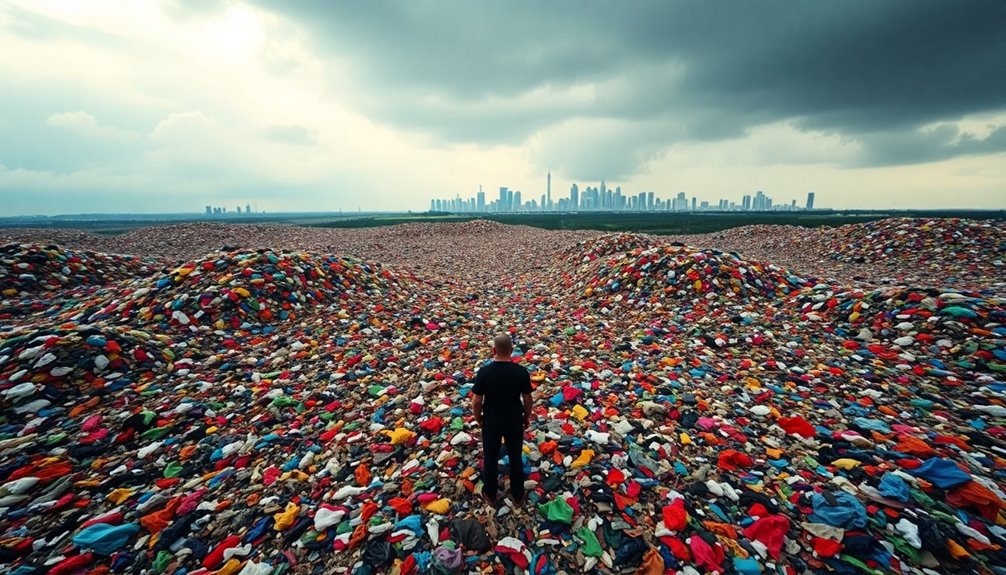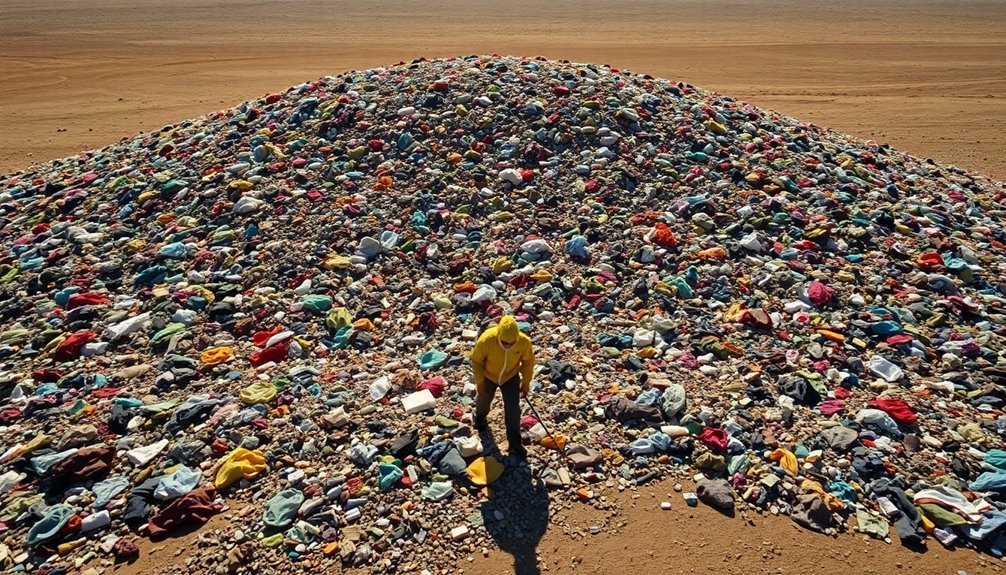As online shopping soars, Europe's textile waste has reached alarming levels, with each citizen discarding about 16 kilograms of textiles annually. Fast fashion's convenience leads to a cycle of buying and tossing, contributing to around 6.95 million tonnes of waste each year. Only 1% of textiles are recycled, exacerbating the environmental impact. Cities are taking action with sustainable initiatives, highlighting a pressing need for change. Discover more about the efforts being made to tackle this growing issue.
Key Takeaways
- EU textile consumption rose to 19 kilograms per citizen in 2022, driven by the convenience of online shopping and fast fashion.
- Approximately 6.95 million tonnes of textile waste are generated annually in the EU, with most discarded items ending up in landfills.
- Each EU citizen discards about 16 kilograms of textiles yearly, significantly contributing to the region's environmental footprint.
- Only 1% of textiles are recycled into new garments, highlighting challenges in the recycling process and low efficiency.
- Initiatives promoting sustainable practices, like clothing libraries and repair incentives, are emerging to combat rising textile waste.

In 2022, each EU citizen bought an average of 19 kilograms of new textiles, highlighting a troubling trend driven by the ease of online shopping. This marks an increase from 17 kilograms in 2019, showcasing how quickly consumption rates are rising. Fast fashion brands make it easy for you to buy cheap clothes and accessories, but this convenience comes at a significant environmental cost.
In 2022, EU citizens' textile purchases surged to 19 kilograms, revealing the environmental toll of convenient online shopping.
With the EU generating around 6.95 million tonnes of textile waste annually, the pressure on our environment is mounting. As you click through those online stores, remember that textiles account for about 5% of the EU's overall environmental footprint. Most of the clothing you discard ends up in landfills or is incinerated, with only 1% being recycled into new garments. Approximately 16 kg of textiles are discarded annually by each EU citizen, underscoring the scale of the waste crisis.
This cycle of buying, using, and discarding is fueled by the rapid access to cheap fashion, making it all too easy to forget the consequences of your purchases. Cities across Europe are recognizing this issue and are taking steps to promote sustainable options. Initiatives like clothing libraries and repair incentives are gaining traction, encouraging you to rethink your consumption habits.
While some cities advocate for slow fashion and provide funding for training, the challenge remains. A mere 12% of textile waste is recycled, and the process is often labor-intensive and costly. Looking ahead, the European textile recycling market is expected to grow, driven by increasing awareness of environmental issues.
Innovative sorting technologies are emerging, helping improve the recycling process. You might find that recycled textiles become more readily available, particularly polyester, which dominates the market. As online shopping continues to rise, it's crucial for you to consider the impact of your choices.
The shift towards a circular economy aims to reduce waste and promote sustainability, but it starts with awareness and action on your part. The future depends on how we adapt our habits today.
Frequently Asked Questions
How Can Consumers Reduce Their Textile Waste While Shopping Online?
You can reduce textile waste while shopping online by prioritizing quality over quantity—invest in durable, eco-friendly pieces.
Support sustainable brands with certifications and opt for classic styles to minimize frequent purchases.
Consider thrifting and using resale platforms to give old clothes new life.
When you're done, donate or sell items instead of tossing them.
Lastly, embrace upcycling and repair services to extend your garments' lifespan and reduce waste effectively.
What Are the Environmental Impacts of Textile Waste in Europe?
When you think of textile waste, picture overflowing landfills, polluted waters, and the air thick with greenhouse gases.
In Europe, textile waste severely impacts the environment. It consumes vast amounts of water and land, contributes to climate change, and releases harmful microplastics.
As fast fashion fuels overconsumption, effective waste management becomes crucial.
You can help by choosing sustainable options and advocating for responsible practices in the industry, protecting the planet for future generations.
Are There Regulations in Place to Manage Textile Waste?
Yes, there're regulations in place to manage textile waste in Europe. The Waste Framework Directive requires countries to set up separate collection systems by 2025.
Extended Producer Responsibility makes producers accountable for their products' entire lifecycle, pushing for sustainability.
Additionally, harmonization efforts streamline compliance across EU nations.
These regulations aim to promote durable, repairable, and recyclable textiles, ultimately reducing the environmental impact of waste and encouraging responsible consumption.
What Role Do Brands Play in Reducing Textile Waste?
Imagine a world where your favorite clothes don't end up in landfills.
Brands play a crucial role in reducing textile waste by adopting sustainable practices. They're launching recycling programs, using eco-friendly materials, and creating circular business models.
How Can Recycling Programs Help Mitigate Textile Waste Issues?
Recycling programs can significantly help you mitigate textile waste issues. By providing clear sorting criteria and education, they empower you to separate reusable textiles from waste effectively.
These programs also create systems for collection, ensuring more materials are recycled rather than landfilled. Additionally, with extended producer responsibility, brands are held accountable for their products, encouraging sustainable practices.
Together, these efforts foster a circular economy, reducing waste and promoting responsible consumption.
Conclusion
As online shopping skyrockets, Europe's textile waste is piling up like a mountain of discarded clothes, threatening our environment. You've got the power to make a difference by being mindful of your purchases and choosing sustainable options. Every small step counts in the fight against this growing crisis. So, next time you're tempted to click "add to cart," think twice and consider the impact on our planet. Together, we can turn this tide of waste into a wave of change.









